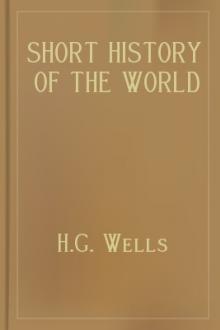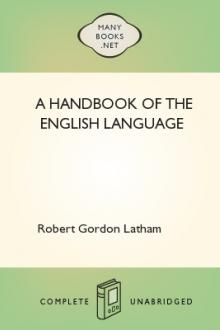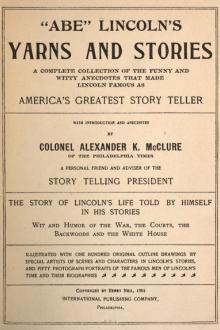A Short History of the World, H. G. Wells [beach books .TXT] 📗

- Author: H. G. Wells
- Performer: -
Book online «A Short History of the World, H. G. Wells [beach books .TXT] 📗». Author H. G. Wells
To the north of both these great empires were barbaric wildernesses. What is now Germany was largely forest lands; the forests extended far into Russia and made a home for the gigantic aurochs, a bull of almost elephantine size. Then to the north of the great mountain masses of Asia stretched a band of deserts, steppes and then forests and frozen lands. In the eastward lap of the elevated part of Asia was the great triangle of Manchuria. Large parts of these regions, stretching between South Russia and Turkestan into Manchuria, were and are regions of exceptional climatic insecurity. Their rainfall has varied greatly in the course of a few centuries They are lands treacherous to man. For years they will carry pasture and sustain cultivation, and then will come an age of decline in humidity and a cycle of killing droughts.
Han Dynasty (contemporary with the late Roman republic and early Empire)
(In the Victoria and Albert Museum)
The western part of this barbaric north from the German forests to South Russia and Turkestan and from Gothland to the Alps was the region of origin of the Nordic peoples and of the Aryan speech. The eastern steppes and deserts of Mongolia was the region of origin of the Hunnish or Mongolian or Tartar or Turkish peoples—for all these several peoples were akin in language, race, and way of life. And as the Nordic peoples seem to have been continually overflowing their own borders and pressing south upon the developing civilizations of Mesopotamia and the Mediterranean coast, so the Hunnish tribes sent their surplus as wanderers, raiders and conquerors into the settled regions of China. Periods of plenty in the north would mean an increase in population there; a shortage of grass, a spell of cattle disease, would drive the hungry warlike tribesmen south.
For a time there were simultaneously two fairly effective Empires in the world capable of holding back the barbarians and even forcing forward the frontiers of the imperial peace. The thrust of the Han empire from north China into Mongolia was strong and continuous. The Chinese population welled up over the barrier of the Great Wall. Behind the imperial frontier guards came the Chinese farmer with horse and plough, ploughing up the grass lands and enclosing the winter pasture. The Hunnish peoples raided and murdered the settlers, but the Chinese punitive expeditions were too much for them. The nomads were faced with the choice of settling down to the plough and becoming Chinese tax-payers or shifting in search of fresh summer pastures. Some took the former course and were absorbed. Some drifted north-eastward and eastward over the mountain passes down into western Turkestan.
Han Dynasty (B.C. 206 - A.D. 220)
(In the Victoria and Albert Museum)
This westward drive of the Mongolian horsemen was going on from 200 B.C. onward. It was producing a westward pressure upon the Aryan tribes, and these again were pressing upon the Roman frontiers ready to break through directly there was any weakness apparent. The Parthians, who were apparently a Scythian people with some Mongolian admixture, came down to the Euphrates by the first century B.C. They fought against Pompey the Great in his eastern raid. They defeated and killed Crassus. They replaced the Seleucid monarchy in Persia by a dynasty of Parthian kings, the Arsacid dynasty.
Dating from before the time of Shi-Hwang-ti. Such a piece of work indicates a high level of comfort and humour
(In the Victoria and Albert Museum)
But for a time the line of least resistance for hungry nomads lay neither to the west nor the east but through central Asia and then south-eastward through the Khyber Pass into India. It was India which received the Mongolian drive in these centuries of Roman and Chinese strength. A series of raiding conquerors poured down through the Punjab into the great plains to loot and destroy. The empire of Asoka was broken up, and for a time the history of India passes into darkness. A certain Kushan dynasty founded by the “Indo- Scythians”—one of the raiding peoples—ruled for a time over North India and maintained a certain order. These invasions went on for several centuries. For a large part of the fifth century A.D. India was afflicted by the Ephthalites or White Huns, who levied tribute on the small Indian princes and held India in terror. Every summer these Ephthalites pastured in western Turkestan, every autumn they came down through the passes to terrorize India.
In the second century A.D. a great misfortune came upon the Roman and Chinese empires that probably weakened the resistance of both to barbarian pressure. This was a pestilence of unexampled virulence. It raged for eleven years in China and disorganized the social framework profoundly. The Han dynasty fell, and a new age of division and confusion began from which China did not fairly recover until the seventh century A.D. with the coming of the great Tang dynasty.
The infection spread through Asia to Europe. It raged throughout the Roman Empire from 164 to 180 A.D. It evidently weakened the Roman imperial fabric very seriously. We begin to hear of depopulation in the Roman provinces after this, and there was a marked deterioration in the vigour and efficiency of government. At any rate we presently find the frontier no longer invulnerable, but giving way first in this place and then in that. A new Nordic people, the Goths, coming originally from Gothland in Sweden, had migrated across Russia to the Volga region and the shores of the Black Sea and taken to the sea and piracy. By the end of the second century they may have begun to feel the westward thrust of the Huns. In 247 they crossed the Danube in a great land raid, and defeated and killed the Emperor Decius in a battle in what is now Serbia. In 236 another Germanic people, the Franks, had broken bounds upon the lower Rhine, and the Alemanni had poured into Alsace. The legions in Gaul beat back their invaders, but the Goths in the Balkan peninsula raided again and again. The province of Dacia vanished from Roman history.
A chill had come to the pride and confidence of Rome. In 270-275 Rome, which had been an open and secure city for three centuries, was fortified by the Emperor Aurelian.
BEFORE we tell of how this Roman empire which was built up in the two centuries B.C., and which flourished in peace and security from the days of Augustus Cæsar onward for two centuries, fell into disorder and was broken up, it may be as well to devote some attention to the life of the ordinary people throughout this great realm. Our history has come down now to within 2000 years of our own time; and the life of the civilized people, both under the Peace of Rome and the Peace of the Han dynasty, was beginning to resemble more and more clearly the life of their civilized successors to-day.
In the western world coined money was now in common use; outside the priestly world there were many people of independent means who were neither officials of the government nor priests; people travelled about more freely than they had ever done before, and there were high roads and inns for them. Compared with the past, with the time before 500 B.C., life had become much more loose. Before that date civilized men had been bound to a district or country, had been bound to a tradition and lived within a very limited horizon; only the nomads traded and travelled.
But neither the Roman Peace nor the Peace of the Han dynasty meant a uniform civilization over the large areas they controlled. There were very great local differences and great contrasts and inequalities of culture between one district and another, just as there are to-day under the British Peace in India. The Roman garrisons and colonies were dotted here and there over this great space, worshipping Roman gods and speaking the Latin language; but where there had been towns and cities before the coming of the Romans, they went on, subordinated indeed but managing their own affairs, and, for a time at least, worshipping their own gods in their own fashion. Over Greece, Asia Minor, Egypt and the Hellenized East generally, the Latin language never prevailed. Greek ruled there invincibly. Saul of Tarsus, who became the apostle Paul, was a Jew and a Roman citizen; but he spoke and wrote Greek and not Hebrew. Even at the court of the Parthian dynasty, which had overthrown the Greek Seleucids in Persia, and was quite outside the Roman imperial boundaries, Greek was the fashionable language. In some parts of Spain and in North Africa, the Carthaginian language also held on for a long time in spite of the destruction of Carthage. Such a town as Seville, which had been a prosperous city long before the Roman name had been heard of, kept its Semitic goddess and preserved its Semitic speech for generations, in spite of a colony of Roman veterans at Italica a few miles away. Septimius Severus, who was emperor from 193 to 211 A.D., spoke Carthaginian as his mother speech. He learnt Latin later as a foreign tongue; and it is recorded that his sister never learnt Latin and conducted her Roman household in the Punic language.
In such countries as Gaul and Britain and in provinces like Dacia (now roughly Roumania) and Pannonia (Hungary south of the Danube), where there were no pre-existing great cities and temples and cultures, the Roman empire did however “Latinize.” It civilized these countries for the first time. It created cities and towns where Latin was from the first the dominant speech, and where Roman gods were served and Roman customs and fashions followed. The Roumanian, Italian, French and Spanish languages, all variations and modifications of Latin, remain to remind us of this extension of Latin speech and customs. North-west Africa also became at last largely Latin-speaking. Egypt, Greece and the rest of the empire to the east were never Latinized. They remained Egyptian and Greek in culture and spirit. And even in Rome, among educated men, Greek was learnt as the language of a gentleman and Greek literature and learning were very, properly preferred to Latin.
In this miscellaneous empire the ways of doing work and business were naturally also very miscellaneous. The chief industry of the settled world was still largely agriculture. We have told how in Italy the sturdy free farmers who were the backbone of the early Roman republic were replaced by estates worked by slave labour after the Punic wars. The Greek world had had very various methods of cultivation, from the Arcadian plan, wherein every free citizen toiled with his own hands, to Sparta, wherein it was a dishonour to work and where agricultural work was done by a special slave class, the Helots. But that was ancient history now, and over most of the Hellenized world the estate system and slave-gangs had spread. The agricultural slaves were captives who spoke many different languages so that they could not understand each other, or they were born slaves; they had no solidarity to resist oppression, no tradition of rights, no knowledge, for they could not read nor write. Although they came to form





Comments (0)